Introduction to Sociology: Gender Role Discrimination in the Caribbean
VerifiedAdded on 2021/10/06
|11
|1610
|100
Essay
AI Summary
This essay, written for an Introduction to Sociology course, argues that gender role discrimination in the workplace in contemporary Caribbean is a thing of the past. The author presents arguments against the opposing view, highlighting the increasing number of women in the workforce and the positive changes in education and opportunities. The essay references historical figures like Dame Mary Eugenia Charles and analyzes data from the Global Gender Gap Report and the Economic Commission for Latin America and the Caribbean to support its claims. The author also discusses the impact of education reforms and international labor organization data to demonstrate the declining trend of gender discrimination. The essay concludes that the Caribbean's dynamic education system and the increasing participation of women in the labor force have rendered gender discrimination in the workplace a thing of the past.
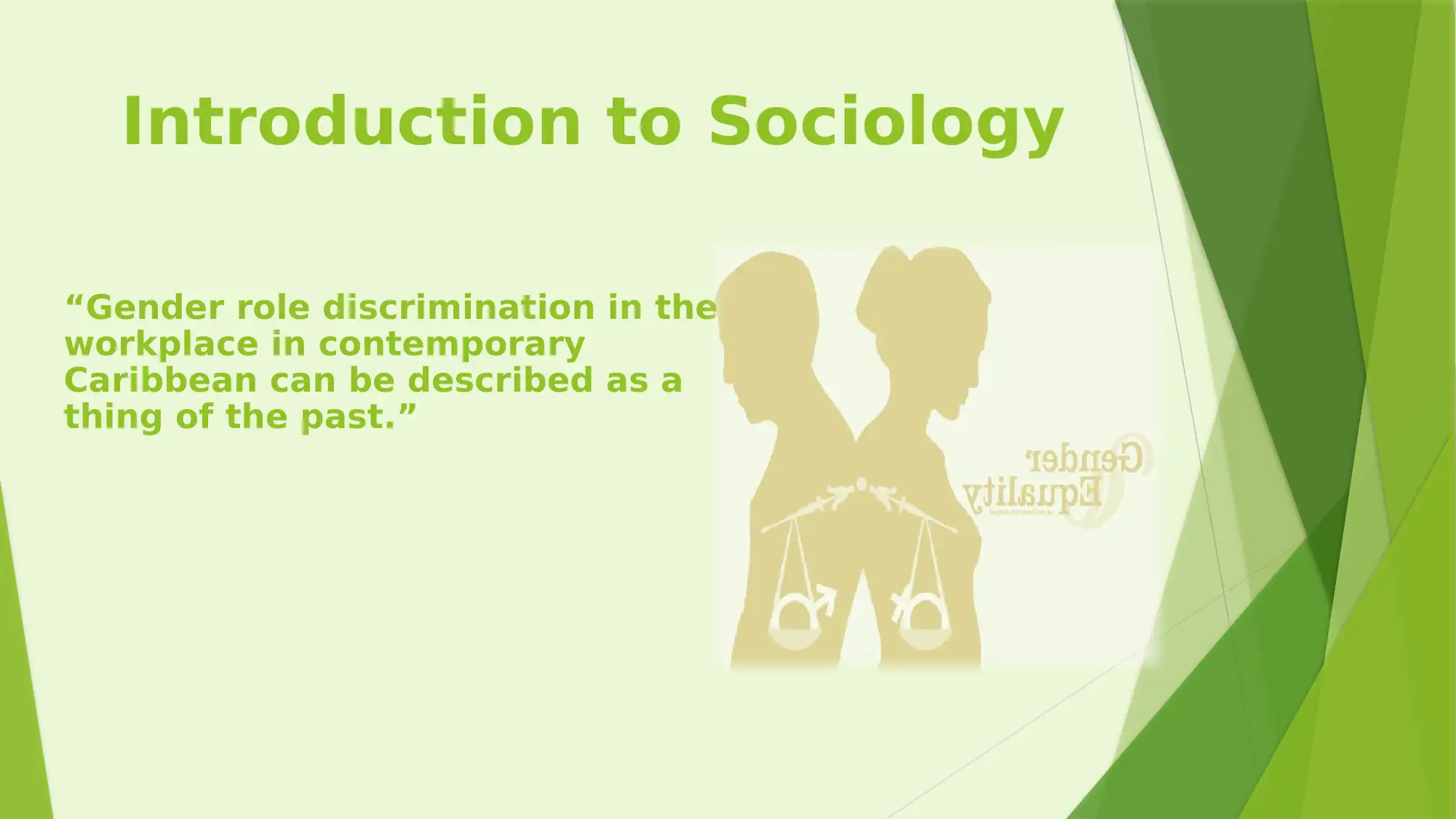
“Gender role discrimination in the
workplace in contemporary
Caribbean can be described as a
thing of the past.”
Introduction to Sociology
workplace in contemporary
Caribbean can be described as a
thing of the past.”
Introduction to Sociology
Paraphrase This Document
Need a fresh take? Get an instant paraphrase of this document with our AI Paraphraser
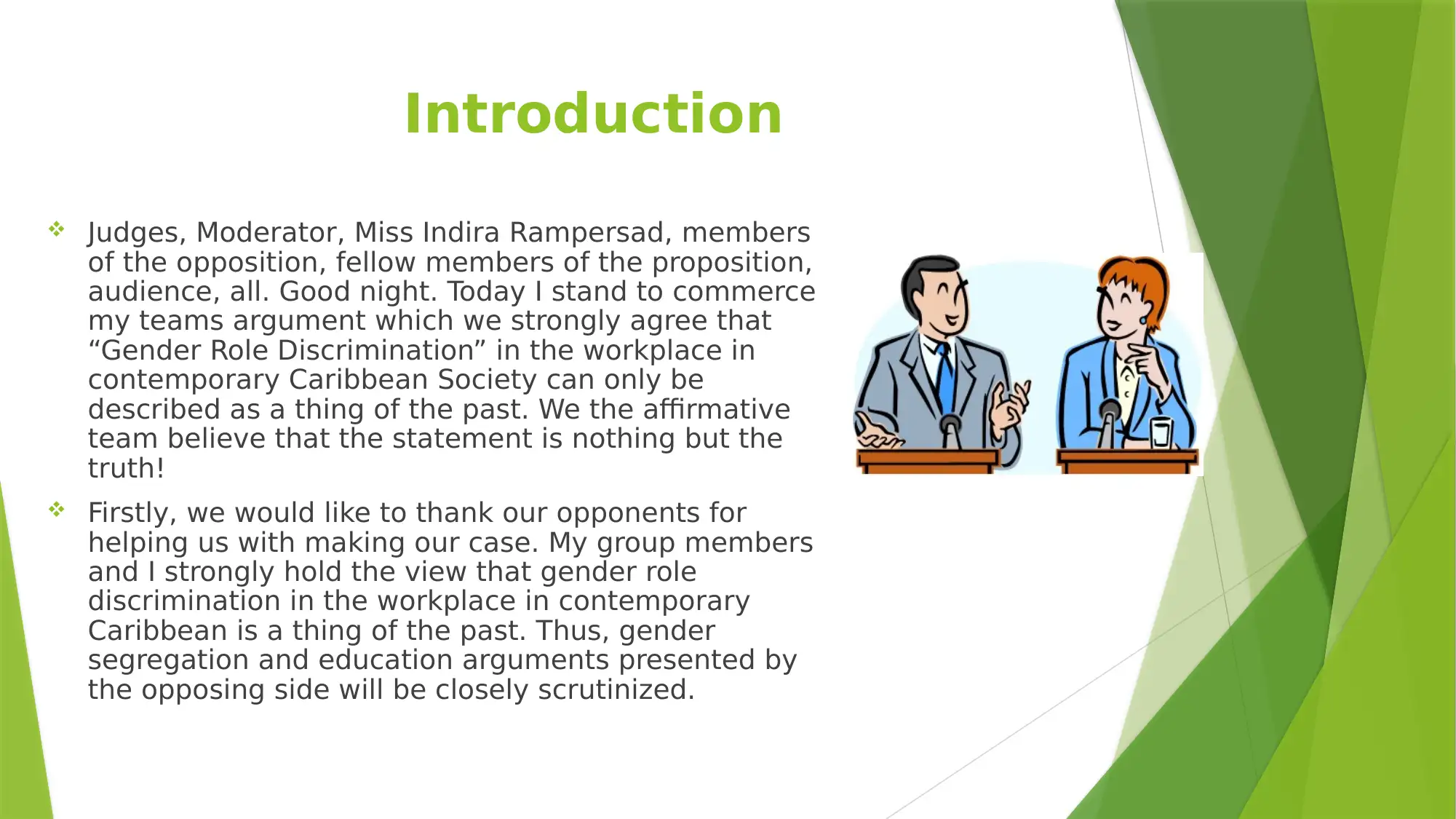
Introduction
Judges, Moderator, Miss Indira Rampersad, members
of the opposition, fellow members of the proposition,
audience, all. Good night. Today I stand to commerce
my teams argument which we strongly agree that
“Gender Role Discrimination” in the workplace in
contemporary Caribbean Society can only be
described as a thing of the past. We the affirmative
team believe that the statement is nothing but the
truth!
Firstly, we would like to thank our opponents for
helping us with making our case. My group members
and I strongly hold the view that gender role
discrimination in the workplace in contemporary
Caribbean is a thing of the past. Thus, gender
segregation and education arguments presented by
the opposing side will be closely scrutinized.
Judges, Moderator, Miss Indira Rampersad, members
of the opposition, fellow members of the proposition,
audience, all. Good night. Today I stand to commerce
my teams argument which we strongly agree that
“Gender Role Discrimination” in the workplace in
contemporary Caribbean Society can only be
described as a thing of the past. We the affirmative
team believe that the statement is nothing but the
truth!
Firstly, we would like to thank our opponents for
helping us with making our case. My group members
and I strongly hold the view that gender role
discrimination in the workplace in contemporary
Caribbean is a thing of the past. Thus, gender
segregation and education arguments presented by
the opposing side will be closely scrutinized.

Gender Segregation
The Negative team has tried to persuade you into believing in their arguments that
gender segregation, gender intimidation and biased opportunities in employment and
education is present in contemporary Caribbean countries when this false!
As was mentioned by the opponents, “there continues to be a low representation of
women in parliament” and made reference to Dame Mary Eugenia Charles of
Dominica as the first female head of state from the English-speaking Caribbean.
That argument is UNTRUE, in fact! Dame Charles paved the way for females to rise
to the highest job position in the Caribbean.
Firstly, In 1970 she formed the Dominica Freedom Party and even if the party was
dominated by males, she held her own. She was highly respected by all members
in the party to the extent that she was voted repeatedly year after year to lead
the group. That shows the overwhelming confidence that both genders forming
the membership had in Mary Eugenia Charles. So opposers is that really “FEELING
STIGMAITZED?!” because, according to your findings women feel “stigmatized
when their work puts them in contact with the public.”
Secondly, By 1980, she gained even greater popularity and lead her party to win
the 1980 general elections and went on to win 1985 and 1990 elections. How
contradicting can our opponents be? She ruled the country for 15 consecutive
years. Prior to that she was the leader of the opposition from 1970 to 1980. That
demonstrates and illustrated that discrimination in the workplace was something
of the past. She did not only break that barrier for Dominica but encourage it
through the Caribbean and the commonwealth of nations and that approach open
several doors for women to hold the top positions in Jamaica, Trinidad and Tobago
and now Barbados. Being alienated in politics, she had to face her opponents with
exemplary courage as she was verbally assaulted on her personal life This Photo by Unknown Author is licensed under CC BY-SA
The Negative team has tried to persuade you into believing in their arguments that
gender segregation, gender intimidation and biased opportunities in employment and
education is present in contemporary Caribbean countries when this false!
As was mentioned by the opponents, “there continues to be a low representation of
women in parliament” and made reference to Dame Mary Eugenia Charles of
Dominica as the first female head of state from the English-speaking Caribbean.
That argument is UNTRUE, in fact! Dame Charles paved the way for females to rise
to the highest job position in the Caribbean.
Firstly, In 1970 she formed the Dominica Freedom Party and even if the party was
dominated by males, she held her own. She was highly respected by all members
in the party to the extent that she was voted repeatedly year after year to lead
the group. That shows the overwhelming confidence that both genders forming
the membership had in Mary Eugenia Charles. So opposers is that really “FEELING
STIGMAITZED?!” because, according to your findings women feel “stigmatized
when their work puts them in contact with the public.”
Secondly, By 1980, she gained even greater popularity and lead her party to win
the 1980 general elections and went on to win 1985 and 1990 elections. How
contradicting can our opponents be? She ruled the country for 15 consecutive
years. Prior to that she was the leader of the opposition from 1970 to 1980. That
demonstrates and illustrated that discrimination in the workplace was something
of the past. She did not only break that barrier for Dominica but encourage it
through the Caribbean and the commonwealth of nations and that approach open
several doors for women to hold the top positions in Jamaica, Trinidad and Tobago
and now Barbados. Being alienated in politics, she had to face her opponents with
exemplary courage as she was verbally assaulted on her personal life This Photo by Unknown Author is licensed under CC BY-SA
⊘ This is a preview!⊘
Do you want full access?
Subscribe today to unlock all pages.

Trusted by 1+ million students worldwide
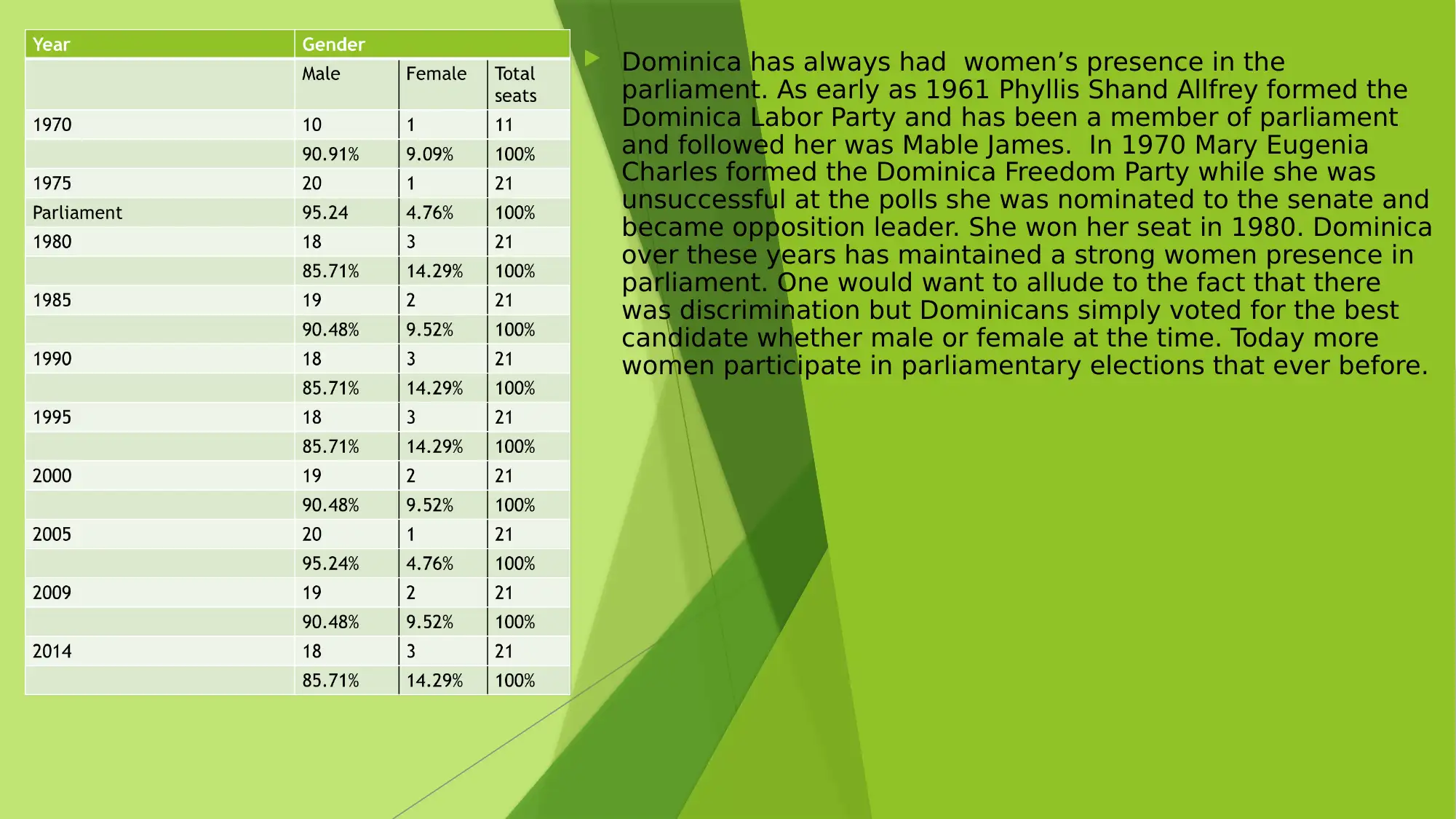
Dominica has always had women’s presence in the
parliament. As early as 1961 Phyllis Shand Allfrey formed the
Dominica Labor Party and has been a member of parliament
and followed her was Mable James. In 1970 Mary Eugenia
Charles formed the Dominica Freedom Party while she was
unsuccessful at the polls she was nominated to the senate and
became opposition leader. She won her seat in 1980. Dominica
over these years has maintained a strong women presence in
parliament. One would want to allude to the fact that there
was discrimination but Dominicans simply voted for the best
candidate whether male or female at the time. Today more
women participate in parliamentary elections that ever before.
parliament. As early as 1961 Phyllis Shand Allfrey formed the
Dominica Labor Party and has been a member of parliament
and followed her was Mable James. In 1970 Mary Eugenia
Charles formed the Dominica Freedom Party while she was
unsuccessful at the polls she was nominated to the senate and
became opposition leader. She won her seat in 1980. Dominica
over these years has maintained a strong women presence in
parliament. One would want to allude to the fact that there
was discrimination but Dominicans simply voted for the best
candidate whether male or female at the time. Today more
women participate in parliamentary elections that ever before.
Paraphrase This Document
Need a fresh take? Get an instant paraphrase of this document with our AI Paraphraser
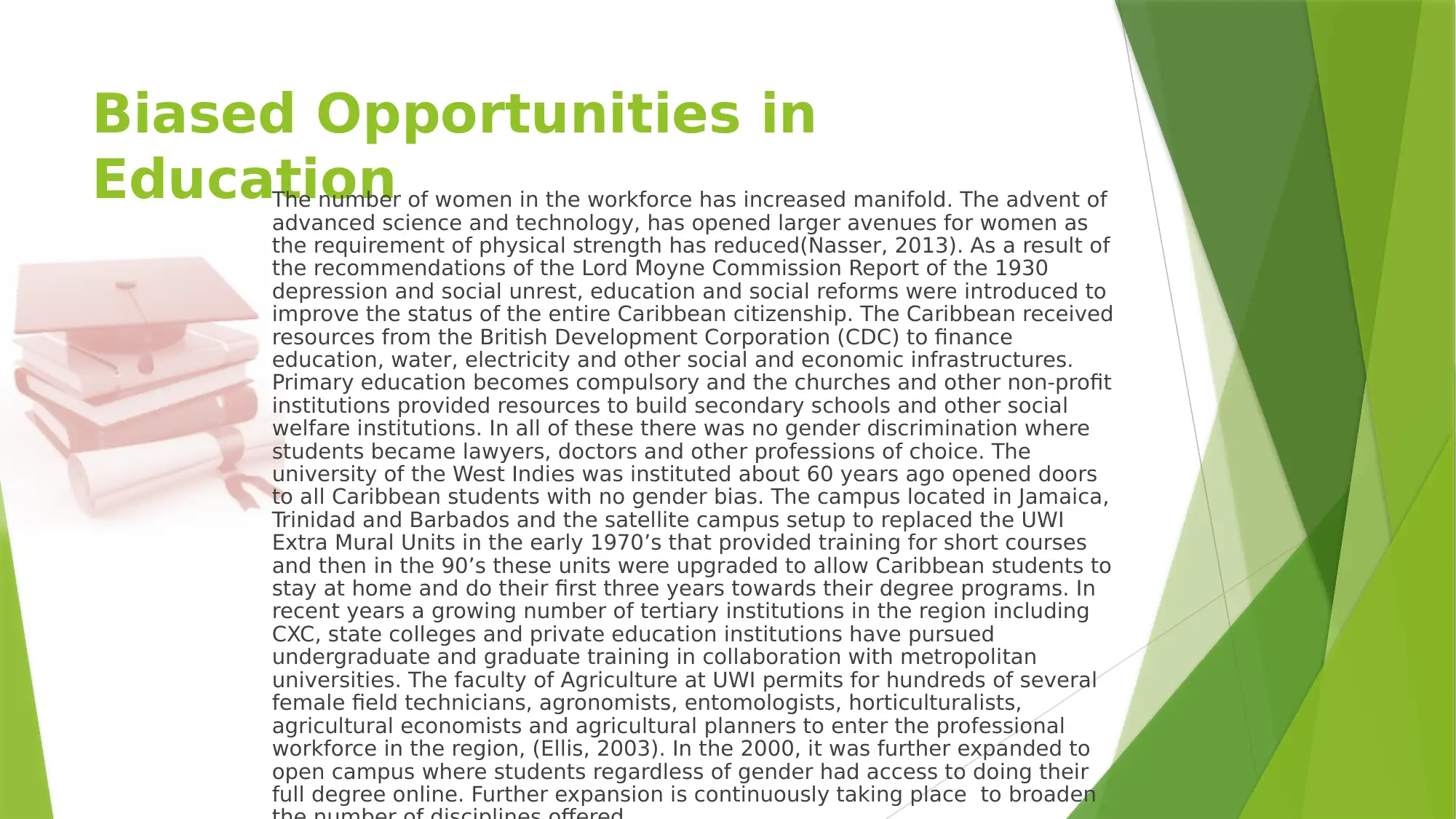
Biased Opportunities in
EducationThe number of women in the workforce has increased manifold. The advent of
advanced science and technology, has opened larger avenues for women as
the requirement of physical strength has reduced(Nasser, 2013). As a result of
the recommendations of the Lord Moyne Commission Report of the 1930
depression and social unrest, education and social reforms were introduced to
improve the status of the entire Caribbean citizenship. The Caribbean received
resources from the British Development Corporation (CDC) to finance
education, water, electricity and other social and economic infrastructures.
Primary education becomes compulsory and the churches and other non-profit
institutions provided resources to build secondary schools and other social
welfare institutions. In all of these there was no gender discrimination where
students became lawyers, doctors and other professions of choice. The
university of the West Indies was instituted about 60 years ago opened doors
to all Caribbean students with no gender bias. The campus located in Jamaica,
Trinidad and Barbados and the satellite campus setup to replaced the UWI
Extra Mural Units in the early 1970’s that provided training for short courses
and then in the 90’s these units were upgraded to allow Caribbean students to
stay at home and do their first three years towards their degree programs. In
recent years a growing number of tertiary institutions in the region including
CXC, state colleges and private education institutions have pursued
undergraduate and graduate training in collaboration with metropolitan
universities. The faculty of Agriculture at UWI permits for hundreds of several
female field technicians, agronomists, entomologists, horticulturalists,
agricultural economists and agricultural planners to enter the professional
workforce in the region, (Ellis, 2003). In the 2000, it was further expanded to
open campus where students regardless of gender had access to doing their
full degree online. Further expansion is continuously taking place to broaden
EducationThe number of women in the workforce has increased manifold. The advent of
advanced science and technology, has opened larger avenues for women as
the requirement of physical strength has reduced(Nasser, 2013). As a result of
the recommendations of the Lord Moyne Commission Report of the 1930
depression and social unrest, education and social reforms were introduced to
improve the status of the entire Caribbean citizenship. The Caribbean received
resources from the British Development Corporation (CDC) to finance
education, water, electricity and other social and economic infrastructures.
Primary education becomes compulsory and the churches and other non-profit
institutions provided resources to build secondary schools and other social
welfare institutions. In all of these there was no gender discrimination where
students became lawyers, doctors and other professions of choice. The
university of the West Indies was instituted about 60 years ago opened doors
to all Caribbean students with no gender bias. The campus located in Jamaica,
Trinidad and Barbados and the satellite campus setup to replaced the UWI
Extra Mural Units in the early 1970’s that provided training for short courses
and then in the 90’s these units were upgraded to allow Caribbean students to
stay at home and do their first three years towards their degree programs. In
recent years a growing number of tertiary institutions in the region including
CXC, state colleges and private education institutions have pursued
undergraduate and graduate training in collaboration with metropolitan
universities. The faculty of Agriculture at UWI permits for hundreds of several
female field technicians, agronomists, entomologists, horticulturalists,
agricultural economists and agricultural planners to enter the professional
workforce in the region, (Ellis, 2003). In the 2000, it was further expanded to
open campus where students regardless of gender had access to doing their
full degree online. Further expansion is continuously taking place to broaden
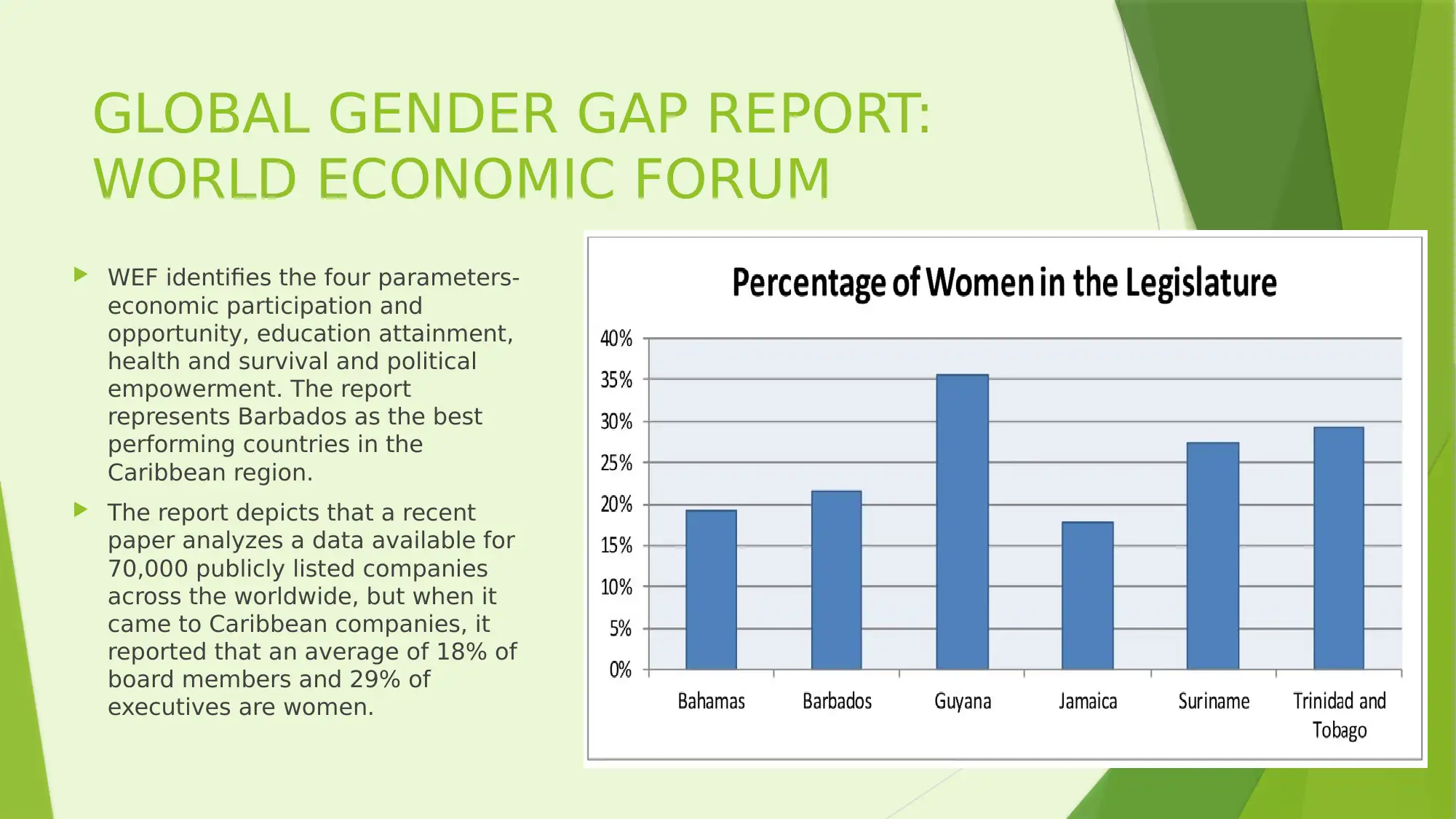
GLOBAL GENDER GAP REPORT:
WORLD ECONOMIC FORUM
WEF identifies the four parameters-
economic participation and
opportunity, education attainment,
health and survival and political
empowerment. The report
represents Barbados as the best
performing countries in the
Caribbean region.
The report depicts that a recent
paper analyzes a data available for
70,000 publicly listed companies
across the worldwide, but when it
came to Caribbean companies, it
reported that an average of 18% of
board members and 29% of
executives are women.
WORLD ECONOMIC FORUM
WEF identifies the four parameters-
economic participation and
opportunity, education attainment,
health and survival and political
empowerment. The report
represents Barbados as the best
performing countries in the
Caribbean region.
The report depicts that a recent
paper analyzes a data available for
70,000 publicly listed companies
across the worldwide, but when it
came to Caribbean companies, it
reported that an average of 18% of
board members and 29% of
executives are women.
⊘ This is a preview!⊘
Do you want full access?
Subscribe today to unlock all pages.

Trusted by 1+ million students worldwide
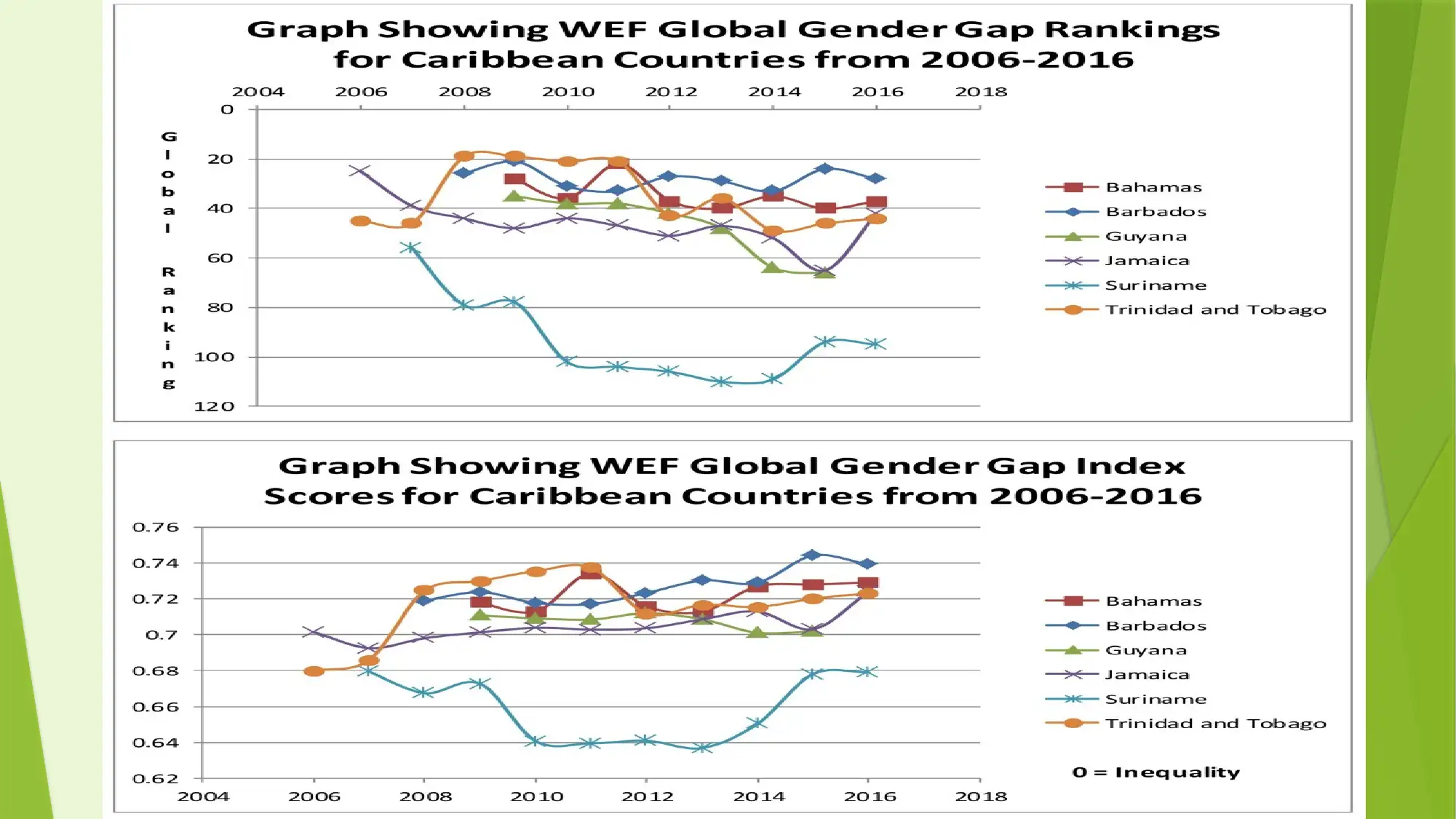
Paraphrase This Document
Need a fresh take? Get an instant paraphrase of this document with our AI Paraphraser
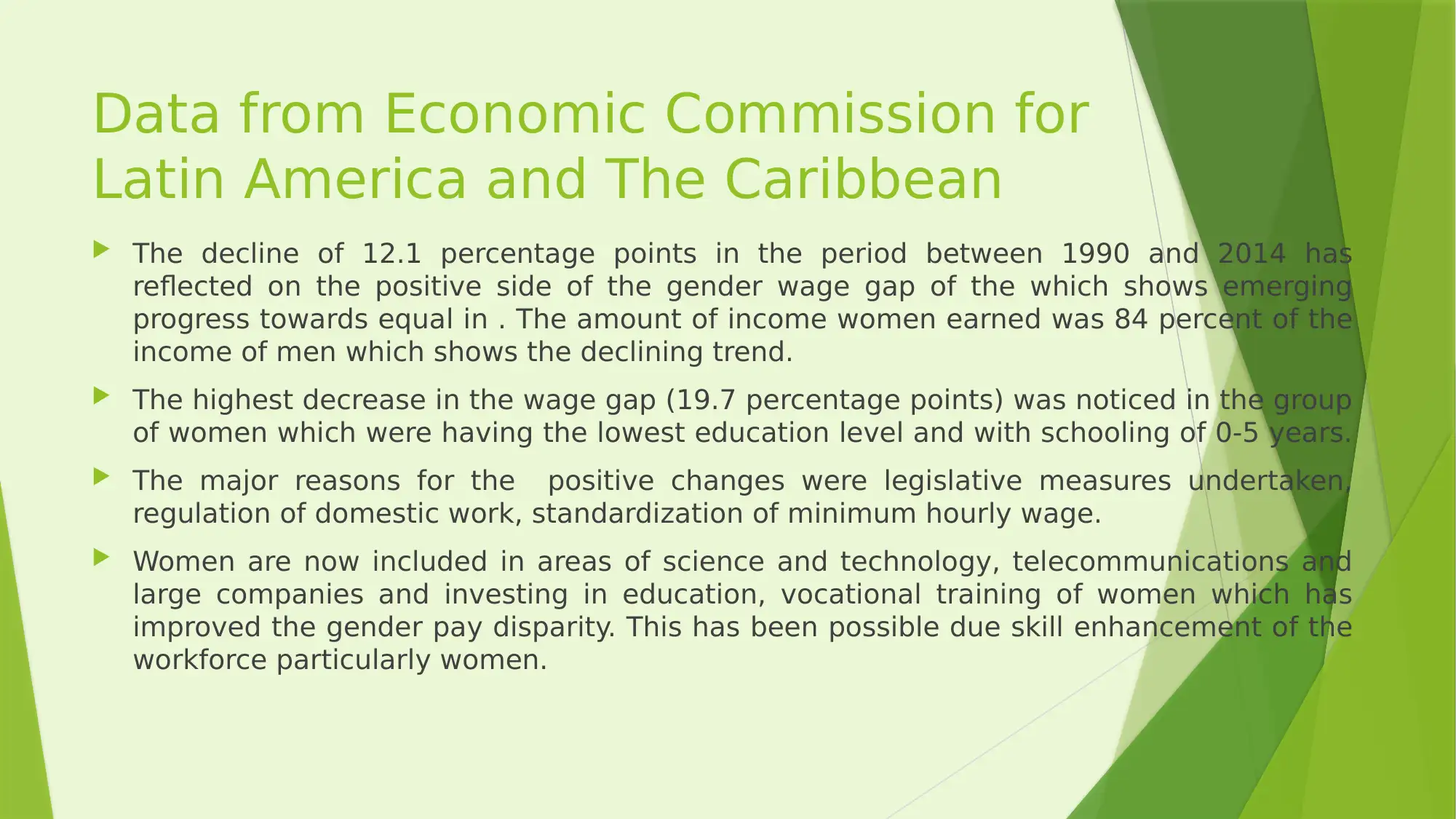
Data from Economic Commission for
Latin America and The Caribbean
The decline of 12.1 percentage points in the period between 1990 and 2014 has
reflected on the positive side of the gender wage gap of the which shows emerging
progress towards equal in . The amount of income women earned was 84 percent of the
income of men which shows the declining trend.
The highest decrease in the wage gap (19.7 percentage points) was noticed in the group
of women which were having the lowest education level and with schooling of 0-5 years.
The major reasons for the positive changes were legislative measures undertaken,
regulation of domestic work, standardization of minimum hourly wage.
Women are now included in areas of science and technology, telecommunications and
large companies and investing in education, vocational training of women which has
improved the gender pay disparity. This has been possible due skill enhancement of the
workforce particularly women.
Latin America and The Caribbean
The decline of 12.1 percentage points in the period between 1990 and 2014 has
reflected on the positive side of the gender wage gap of the which shows emerging
progress towards equal in . The amount of income women earned was 84 percent of the
income of men which shows the declining trend.
The highest decrease in the wage gap (19.7 percentage points) was noticed in the group
of women which were having the lowest education level and with schooling of 0-5 years.
The major reasons for the positive changes were legislative measures undertaken,
regulation of domestic work, standardization of minimum hourly wage.
Women are now included in areas of science and technology, telecommunications and
large companies and investing in education, vocational training of women which has
improved the gender pay disparity. This has been possible due skill enhancement of the
workforce particularly women.
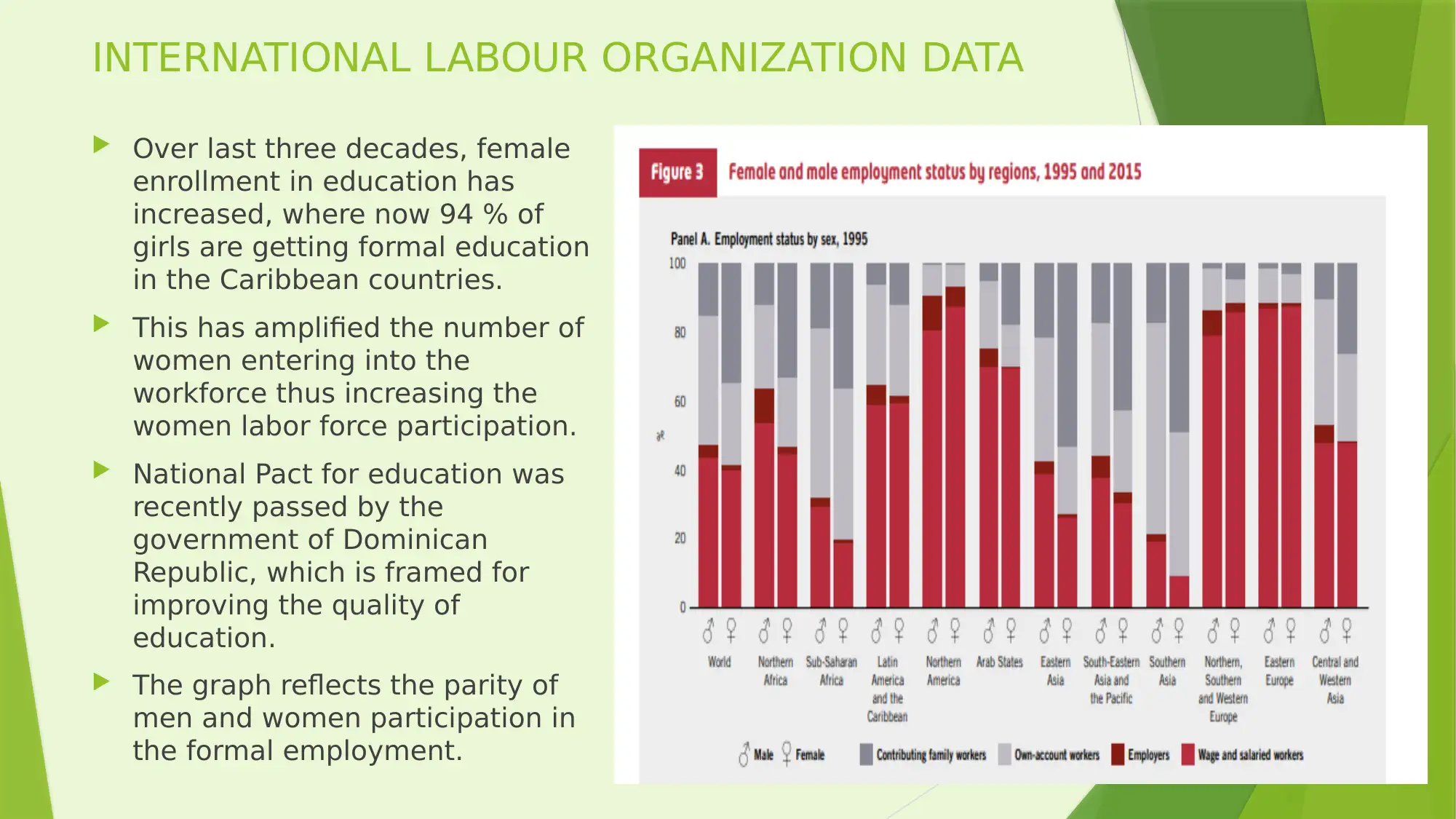
INTERNATIONAL LABOUR ORGANIZATION DATA
Over last three decades, female
enrollment in education has
increased, where now 94 % of
girls are getting formal education
in the Caribbean countries.
This has amplified the number of
women entering into the
workforce thus increasing the
women labor force participation.
National Pact for education was
recently passed by the
government of Dominican
Republic, which is framed for
improving the quality of
education.
The graph reflects the parity of
men and women participation in
the formal employment.
Over last three decades, female
enrollment in education has
increased, where now 94 % of
girls are getting formal education
in the Caribbean countries.
This has amplified the number of
women entering into the
workforce thus increasing the
women labor force participation.
National Pact for education was
recently passed by the
government of Dominican
Republic, which is framed for
improving the quality of
education.
The graph reflects the parity of
men and women participation in
the formal employment.
⊘ This is a preview!⊘
Do you want full access?
Subscribe today to unlock all pages.

Trusted by 1+ million students worldwide

Conclusion
The Caribbean therefore has a dynamic and revolutionary
education system that turns out tens and tens of thousands of
professionals yearly. The CSME and Caribbean integration
movement today include Martinique, Haiti, Suriname and Belize
as members while Cuba and Venezuela are observers These
countries together provide opportunities for citizens of the
Caribbean to obtain tertiary education throughout the Caribbean.
Cuba alone provides thousands of scholarships on a yearly basis
to CARICOM and there is no stereotyping or discrimination
whatsoever. The result is more females pursue opportunities to
studies in more disciplines once reserved for the males. As the
participation of women increased in the labor force both laterally
and vertically in the last three to four decades gender
discrimination in the workplace has become a thing of the past in
contemporary Caribbean.
The Caribbean therefore has a dynamic and revolutionary
education system that turns out tens and tens of thousands of
professionals yearly. The CSME and Caribbean integration
movement today include Martinique, Haiti, Suriname and Belize
as members while Cuba and Venezuela are observers These
countries together provide opportunities for citizens of the
Caribbean to obtain tertiary education throughout the Caribbean.
Cuba alone provides thousands of scholarships on a yearly basis
to CARICOM and there is no stereotyping or discrimination
whatsoever. The result is more females pursue opportunities to
studies in more disciplines once reserved for the males. As the
participation of women increased in the labor force both laterally
and vertically in the last three to four decades gender
discrimination in the workplace has become a thing of the past in
contemporary Caribbean.
Paraphrase This Document
Need a fresh take? Get an instant paraphrase of this document with our AI Paraphraser

Bibliography
Ellis, P. (2003). Women, Gender and Development in the Caribbean. London and Kingston:
Ian Randle Publishers. Retrieved from
https://books.google.com.ag/books?id=uN7L3cTlgG4C&printsec=frontcover&dq=women+
and+change+in+the+caribbean&hl=en&sa=X&ved=0ahUKEwiCgMjDgL7eAhVDvlMKHTHlD
LEQ6AEILzAC#v=onepage&q=women%20and%20change%20in%20the%20caribbean&f=fa
lse
Nasser, M. (2013). Sociology for Caribbean Students (2nd Edition ed.). Kingston: Ian Randle
Publishers. Retrieved from
https://web-b-ebscohost-com.library.open.uwi.edu/ehost/detail/detail?vid=0&sid=5bd3b
76a-5947-4e77-8c62-18148313d6cf%40pdc-v-sessmgr02&bdata=JnNpdGU9ZWhvc3QtbGl
2ZQ%3d%3d#AN=668414&db=nlebk
Pattulo, P. (2005, September 08). The Guardian. Retrieved from
https://www.theguardian.com/news/2005/sep/08/guardianobituaries.pollypattullo
Ellis, P. (2003). Women, Gender and Development in the Caribbean. London and Kingston:
Ian Randle Publishers. Retrieved from
https://books.google.com.ag/books?id=uN7L3cTlgG4C&printsec=frontcover&dq=women+
and+change+in+the+caribbean&hl=en&sa=X&ved=0ahUKEwiCgMjDgL7eAhVDvlMKHTHlD
LEQ6AEILzAC#v=onepage&q=women%20and%20change%20in%20the%20caribbean&f=fa
lse
Nasser, M. (2013). Sociology for Caribbean Students (2nd Edition ed.). Kingston: Ian Randle
Publishers. Retrieved from
https://web-b-ebscohost-com.library.open.uwi.edu/ehost/detail/detail?vid=0&sid=5bd3b
76a-5947-4e77-8c62-18148313d6cf%40pdc-v-sessmgr02&bdata=JnNpdGU9ZWhvc3QtbGl
2ZQ%3d%3d#AN=668414&db=nlebk
Pattulo, P. (2005, September 08). The Guardian. Retrieved from
https://www.theguardian.com/news/2005/sep/08/guardianobituaries.pollypattullo
1 out of 11
Your All-in-One AI-Powered Toolkit for Academic Success.
+13062052269
info@desklib.com
Available 24*7 on WhatsApp / Email
![[object Object]](/_next/static/media/star-bottom.7253800d.svg)
Unlock your academic potential
Copyright © 2020–2025 A2Z Services. All Rights Reserved. Developed and managed by ZUCOL.